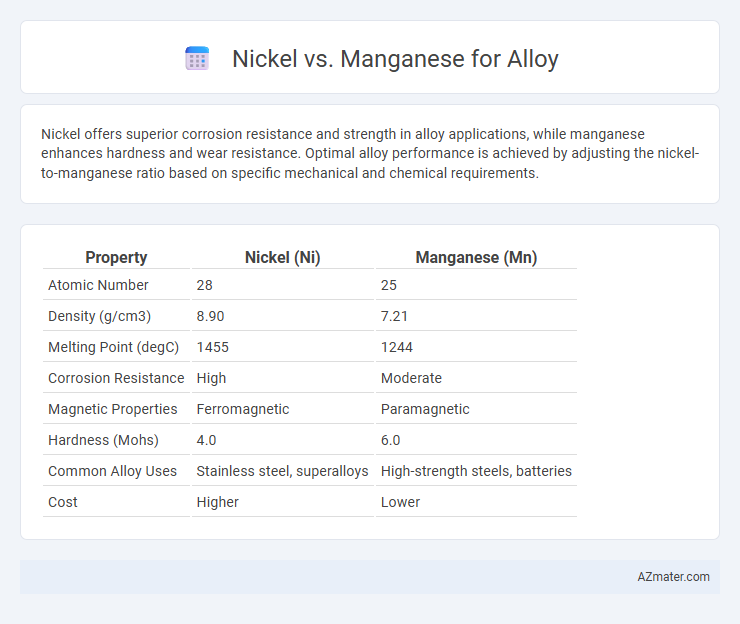Nickel offers superior corrosion resistance and strength in alloy applications, while manganese enhances hardness and wear resistance. Optimal alloy performance is achieved by adjusting the nickel-to-manganese ratio based on specific mechanical and chemical requirements.
Table of Comparison
| Property | Nickel (Ni) | Manganese (Mn) |
|---|---|---|
| Atomic Number | 28 | 25 |
| Density (g/cm3) | 8.90 | 7.21 |
| Melting Point (degC) | 1455 | 1244 |
| Corrosion Resistance | High | Moderate |
| Magnetic Properties | Ferromagnetic | Paramagnetic |
| Hardness (Mohs) | 4.0 | 6.0 |
| Common Alloy Uses | Stainless steel, superalloys | High-strength steels, batteries |
| Cost | Higher | Lower |
Introduction to Nickel and Manganese in Alloys
Nickel enhances alloy corrosion resistance, toughness, and strength, making it essential in stainless steels and superalloys used in aerospace and chemical industries. Manganese improves hardness, wear resistance, and deoxidizes steel, playing a critical role in steel alloys and battery cathodes. Both elements contribute unique properties that optimize alloy performance under diverse operating conditions.
Chemical Properties: Nickel vs Manganese
Nickel exhibits excellent corrosion resistance and high tensile strength due to its face-centered cubic crystal structure, enhancing alloy durability and heat resistance. Manganese, with its body-centered cubic structure, primarily increases hardness and abrasion resistance, acting as a deoxidizer and desulfurizer in steel alloys. The combination of nickel's chemical inertness and manganese's affinity for sulfur creates alloys with balanced toughness, wear resistance, and chemical stability.
Mechanical Strength and Durability
Nickel alloys exhibit superior mechanical strength and corrosion resistance, making them ideal for high-stress and high-temperature applications. Manganese, when added to steel alloys, enhances toughness and wear resistance but generally provides lower tensile strength compared to nickel-based alloys. The choice between nickel and manganese depends on the specific durability requirements, with nickel favored for extreme environments and manganese for cost-effective toughness improvements.
Corrosion Resistance Comparison
Nickel offers superior corrosion resistance compared to manganese, particularly in aggressive environments such as acidic or chloride-rich conditions, making it ideal for stainless steel and chemical processing alloys. Manganese, while enhancing strength and toughness, provides moderate corrosion resistance but is less effective against pitting and crevice corrosion. Alloys with higher nickel content exhibit enhanced durability and longevity in corrosive applications compared to manganese-rich alloys.
Impact on Alloy Hardness
Nickel significantly increases alloy hardness by promoting a stable face-centered cubic (FCC) structure, which enhances toughness and resistance to deformation. Manganese contributes to hardness through solid solution strengthening and the formation of Mn-rich precipitates, improving wear resistance and tensile strength. Combining nickel and manganese in alloys results in synergistic hardening effects, optimizing both strength and durability for industrial applications.
Alloy Applications: Industrial Usage
Nickel enhances alloy corrosion resistance and strength, making it ideal for aerospace, chemical processing, and marine industries, where durability under extreme conditions is crucial. Manganese improves wear resistance and toughness, commonly used in steel manufacturing for construction, automotive, and heavy machinery applications. Both elements are essential in alloy formulation, but nickel is preferred for high-performance environments, while manganese is favored for cost-effective structural reinforcement.
Cost and Availability of Nickel and Manganese
Nickel typically commands a higher price than manganese due to its extensive industrial applications and relative scarcity, impacting alloy production costs significantly. Manganese is more abundant and widely distributed globally, making it a cost-effective alternative for alloying, especially in steel manufacturing. The availability of manganese ensures stable supply chains, whereas nickel's supply can be subject to geopolitical and mining constraints, influencing market prices and alloy formulation choices.
Environmental and Health Considerations
Nickel alloys offer superior corrosion resistance but pose higher environmental and health risks due to nickel's potential to cause allergic reactions and respiratory issues during manufacturing. Manganese, essential for alloy strength and hardness, has lower toxicity but excess exposure can lead to neurological problems, emphasizing careful handling and regulation. Sustainable alloy production requires balancing nickel's durability benefits with manganese's safer profile to minimize environmental impact and worker health hazards.
Innovations in Nickel and Manganese Alloying
Innovations in nickel and manganese alloying have significantly enhanced mechanical properties and corrosion resistance in advanced materials. Nickel alloys offer superior strength and high-temperature stability, making them ideal for aerospace and marine applications, while manganese additions improve hardness and wear resistance, essential for steel and battery technologies. Recent developments integrate both elements to optimize performance in energy storage and structural components, driving advancements in lightweight, durable alloys.
Choosing the Right Element: Nickel or Manganese
Nickel offers superior corrosion resistance and toughness, making it ideal for stainless steel and high-strength alloys used in harsh environments. Manganese enhances hardness and wear resistance while improving deoxidation and sulfur fixation, commonly used in structural steels and tool alloys. Selecting between nickel and manganese depends on the specific performance requirements such as corrosion resistance, strength, or durability needed for the alloy's application.

Infographic: Nickel vs Manganese for Alloy
 azmater.com
azmater.com